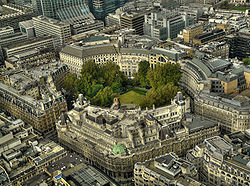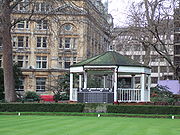
Finsbury Circus
Encyclopedia

City of London
The City of London is a small area within Greater London, England. It is the historic core of London around which the modern conurbation grew and has held city status since time immemorial. The City’s boundaries have remained almost unchanged since the Middle Ages, and it is now only a tiny part of...
, England
England
England is a country that is part of the United Kingdom. It shares land borders with Scotland to the north and Wales to the west; the Irish Sea is to the north west, the Celtic Sea to the south west, with the North Sea to the east and the English Channel to the south separating it from continental...
; with an area of 2.2 hectares it is the largest public open space within the City's boundaries. It has an immaculately maintained Lawn Bowls club in the centre, which has existed in the gardens since 1925. A bandstand
Bandstand
A bandstand is a circular or semicircular structure set in a park, garden, pier, or indoor space, designed to accommodate musical bands performing concerts...
, built in 1955, is located nearby.
The circus was created in 1812 on an area which was originally part of Finsbury Manor, having existed since 1527, on which the second Bethlem Royal Hospital
Bethlem Royal Hospital
The Bethlem Royal Hospital is a psychiatric hospital located in London, United Kingdom and part of the South London and Maudsley NHS Foundation Trust. Although no longer based at its original location, it is recognised as the world's first and oldest institution to specialise in mental illnesses....
had stood since 1675. The original houses, the last of which were demolished in 1921, were intended for merchants and gentlemen, but were soon broken up internally and leased for solicitors and other professions. The gardens, featuring a circuit of lime trees
Tilia
Tilia is a genus of about 30 species of trees native throughout most of the temperate Northern Hemisphere. The greatest species diversity is found in Asia, and the genus also occurs in Europe and eastern North America, but not western North America...
, were developed by William Montague to the specifications of the architect George Dance the Younger
George Dance the Younger
George Dance the Younger was an English architect and surveyor. The fifth and youngest son of George Dance the Elder, he came from a distinguished family of architects, artists and dramatists...
in 1815. In 1819 the London Institution
London Institution
The London Institution was an educational institution founded in London in 1806...
moved into "ingeniously planned and elegantly detailed" premises designed by William Brooks at the north end of the circus; it closed in 1912 and the buildings were used for the University of London until their demolition in 1936.
The circus was opened as a public park in the early 20th century, under powers granted to the City of London Corporation in the City of London (Various Powers) Act 1900. The gardens had previously been a private space for the use of the freeholders or lease-holders of the surrounding buildings, who objected to their compulsory purchase, fearing that their use by the public would create a nuisance which would lower the value of their property. The campaign to make them a public space was led by Alpheus Morton, deputy-Alderman for Farringdon Without
Farringdon Without
Farringdon Without is a Ward in the City of London, England. The Ward covers the western fringes of the City, including the Middle Temple, Inner Temple, Smithfield Market and St Bartholomew's Hospital, as well as the area east of Chancery Lane...
and a member of the Corporations' Streets Committee, and the circus became known with the Corporation as "Morton's Park".
Fronting the northwest quadrant of the oval, with fronts on roads entering the Circus from the west stands Edwin Lutyens
Edwin Lutyens
Sir Edwin Landseer Lutyens, OM, KCIE, PRA, FRIBA was a British architect who is known for imaginatively adapting traditional architectural styles to the requirements of his era...
's massive Britannic House (1921–25, listed Grade II), designed for the Anglo-Persian Oil Company
Anglo-Persian Oil Company
The Anglo-Persian Oil Company was founded in 1908 following the discovery of a large oil field in Masjed Soleiman, Iran. It was the first company to extract petroleum from the Middle East...
, which became BP
BP
BP p.l.c. is a global oil and gas company headquartered in London, United Kingdom. It is the third-largest energy company and fourth-largest company in the world measured by revenues and one of the six oil and gas "supermajors"...
; its free-standing architectural sculptures are by Francis Derwent Wood
Francis Derwent Wood
Francis Derwent Wood RA was a sculptor, born in Keswick, Cumberland, in England's Lake District.-Early life:Wood studied in Germany and returned to London in 1887 to work under Edouard Lanteri and Sir Thomas Brock; he taught at the Glasgow School of Art from 1897 through 1905 and was professor of...
. It was built on the site of the last remaining original houses.

Moorgate station
Moorgate station is a central London railway terminus and London Underground station on Moorgate in the City of London; it provides National Rail services by First Capital Connect for Hertford, Welwyn Garden City and Letchworth and also serves the Circle, Hammersmith & City, Metropolitan Lines and...
, to the West, and the park is also close to Liverpool Street Station
Liverpool Street station
Liverpool Street railway station, also known as London Liverpool Street or simply Liverpool Street, is both a central London railway terminus and a connected London Underground station in the north-eastern corner of the City of London, England...
; both are within about two hundred meters. It is located in the Coleman Street
Coleman Street
Coleman Street is a street and one of the 25 ancient wards in the City of London.- The Ward :Warren Stormes Hale, Lord Mayor of London in 1864, was the Ward’s most notable civic dignitary...
ward.
Finsbury Circus has been used as the finish point for the Miglia Quadrato
Miglia Quadrato
The Miglia Quadrato is an annual car treasure hunt which takes place on the second or third weekend in May within the City of London . It is organised by the United Hospitals and University of London Motoring Club...
each year. In recent years it has also played host to the start of the Miglia Quadrato since the event start was removed from Smithfield Market.
Crossrail
During the years 1860-65 Finsbury Circus was threatened with demolition in favour of a railway station; public protests averted the loss, but in 1869 the oval was tunnelled for the Metropolitan RailwayMetropolitan railway
Metropolitan Railway can refer to:* Metropolitan line, part of the London Underground* Metropolitan Railway, the first underground railway to be built in London...
. Today Finsbury Circus is one of the main worksites for the construction of Crossrail
Crossrail
Crossrail is a project to build a major new railway link under central London. The name refers to the first of two routes which are the responsibility of Crossrail Ltd. It is based on an entirely new east-west tunnel with a central section from to Liverpool Street station...
in the area. From 2010 to 2016 much of the gardens will be taken up in order for the massive project to be constructed. It will be fully restored once construction work is finished, with a possibility the fountains will be returned to full working order.

